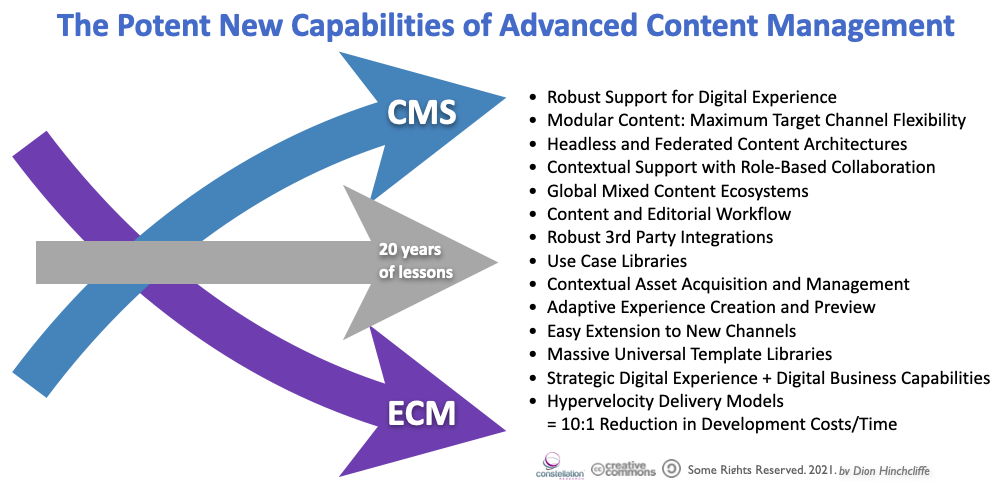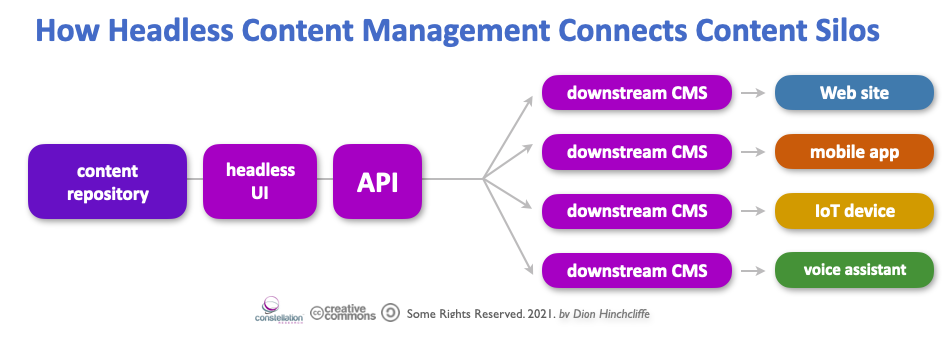In my new research report exploring the future of content management, I examined the many new attributes and capabilities that a vital new category of content management services provides. Known as advanced content management, some of these improvements offered by these new types of platforms have led to a literal revolution in the art-of-the-possible when it comes to managing today's complex content ecosystems. However, the advancements have been quite rapid and so I find that that many organizations are still in the process of learning to fully appreciate and effectively absorb how these potent new features can transform what they do.
As shown in the first figure below, there are a number of compelling new capabilities that have emerged from hard won lessons over the years from both the traditional content management as well as enterprise content management (CMS) industries as they sought to reconcile early generations of such tools with what organizations actually needed to do with their content as a business and lessons learned in general from the last decade of operational experiences in the field.
For a limited time: A complimentary copy of my new report on The Future of Content Management
Of all these advances, however, there is one that stands head and shoulders above the others. That's because it has become a foundational capability that makes today’s more complex and sophisticated content scenarios not just possible, but straightforward and easy to manage.
Specifically, I am referring to the so-called “headless” capability of today's advanced content management systems. In the past, the traditional content management approach was to manage content by putting everything in a single bucket: Content, images, HTML, CSS, everything. This made it impossible to reuse the content easily because it was commingled with code. Even worse, all content typically was handled inside a single platform, not recognizing that today content must be managed from and delivered to whatever digtal touchpoint it needs to be on to satisfy the needs of the business with as little effort as possible.
As digital platforms have evolved to fill far more niches in our businesses, the need for more flexible ccntent services has emerged. Now, enterprises are developing websites, mobile sites, apps, digital displays, connected devices, and conversational interfaces that need access to content stores, wherever they might be, or perhaps one master content source at a central headquarters.
What is headless content management
As I highlighted in my research report, a headless CMS is any type of back-end content management system where the content repository body is separated or decoupled from the presentation layer, or the head. Content that is housed in a headless CMS is delivered via an industry standard interface (an API) for seamless display across different devices.
By defining this simple industry standard, the content management industry, and all the platforms that support it, have enabled virtually any kind of arrangement of different content systems into one functioning ecosystem.
The actual benefits of headless content management
One advantage of this decoupled approach is that content can be sent via the interface to multiple display types, for example, mobile, wearable, and Internet of Things (IoT) devices from a single content management system, alongside the website it's hosted on. A minor disadvantage of headless, however, is the requirement to maintain two or more separate content systems for a single site, which can require more resources. However, in practice, organizations often maintain different content management systems to their advantage because they offer different features that are uniquely designed for the strengths of a particular channel or use case.
Those who not only adopt headless content management standards for their content management systems but fully take advantage of what it offers, can realize the following benefits.
- A non-linear productivity improvement. The more content management systems an organization has, the more content that has to be manually moved around in order to get it to the desired locations. With headless content management, one headless content management system can seamless publish to an unlimited number of downstream content management systems automatically, and with no manual effort. For very large content ecosystems, this can literally be a 100-fold improvement in productivity.
- Greater consistency, quality, and reach in content distribution and publishing. Headless content ecosystems are much more reliable in terms of getting changes propagated to downstream systems and keeping them in sync accurately. This increases the overall quality of content production and distribution processes. It also makes it far likelier the right content is delivered at the right place at the right time.
- It offers a strategic system that runs more like their business. Headless content management systems are connected into content networks that look like the underlying business, whether it is publishing news in multiple languages on different sites around the world, maintaining documentation for a global company with different divisions, or maintaining a series of marketing microsites. The advantage of this is that content management flows mirror what the business does more naturally while requiring only some oversight instead of continuous effort to keep the business operating seamlssly, with its content flowing steadily as desired.
However, one obstacle to headless content management is that it does require a more sophisticated understanding of how federated content architectures work. In other words, a bit of technical skill and conceptual understanding in this area. However, even if it’s a bit of learning effort, a good working understanding of headless quickly pays off with all the attendant benefits cited above. This system runs like the business as a technical realization of what the business actually does, instead of relying on manual operation (importing and exporting content, etc.) to make it so. FInally, it's also clear that headless is here to stay, and organizations must develop experience with it.
Those looking on capitalizing on the considerable power of advanced capabilities of headless content management have to take care of a couple of other things too, such as making sure all their content management systems are headless capable and producing their content in a format that can be easily federated across many different channels. For most non-trivial use cases, headless content management provides businesses with a sustainable strategic improvement to their operations.
Additional Reading
The future of enterprise content is modular and headless | ZDNet
How CXOs Can Attain Minimum Viable Digital Experience for Customers, Employees, and Partners
To Strategically Scale Digital, Enterprises Must Have a Multicloud Experience Integration Stack




0 Commentaires